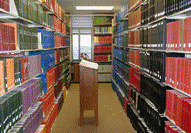Libraries, University of Nebraska-Lincoln

University of Nebraska-Lincoln Libraries: Collection Development Policies
Date of this Version
1-2010
Document Type
Article
Abstract
I. History: While rare books and manuscripts have been acquired since the University of Nebraska was founded, it was not until the 1970s that a concerted effort was made to create a separate Rare Books and Special Collections unit. During the 1970s, librarians identified rare books or special collections within the existing general collections, identified new space for these materials, cataloged them, created collection development criteria, and began providing services through the assignment of the first full-time special collections librarian. One role for the special collections librarian was to seek funding through donations for continued development of the special collections. The University Archives were formed officially in 1968 with the appointment of the first University Archivist. In 1978, the UNL Archives were merged with the Rare Books and Special Collections unit and became the University Archives & Special Collections. Collection development policies and criteria for the University Archives & Special Collections have evolved through the years and the different versions of the documents are available in the Archives’ management files under “Collection Development Policy.”
II. Mission: The mission of the UNL Libraries’ University Archives & Special Collections is to select, preserve, arrange, describe, provide reference assistance for, and promote the use of rare and unique research materials. The unit maintains these research materials because they are best managed separately from the general collections due to their rare or unique qualities, source, physical form, or subject area.
III. Collecting scope: The University Archives & Special Collections’ subject area concentrations spring from major research/education areas at the University of Nebraska-Lincoln. The collections are composed of rare and unique documentary materials created and accumulated by UNL and its members as well as from individuals and organizations external to the University. The collecting interests and the extent of collecting activity in them increases and decreases over time as academic research programs develop and diminish at UNL. The purpose of this approach is to provide the UNL research community with the rate and unique research materials these users require. Collections will, to the extent possible, anticipate future research needs.
Collection strengths are reflected in the University Archives, manuscripts, rare books, ephemeral print materials, photographic collections, and in digital texts. Areas of strength include the following:
Archives and Special Collections CD Policy 2009
2
Agriculture
Examples: Permanent records of the Nebraska Agricultural Experiment Station, UNL Cooperative Extension Service, Institute of Agriculture and Natural Resources, and Women in Farm Economics (WIFE)
American Art and Artists’ Books
Examples: The Stuart Embry Library of American Art and the Blue Heron Press Artists’ Books Collection
Ethnic American Collections
Examples: Czech Heritage collections, Japanese American/Asian Collection, Karlis Ulmanis, Latvian and Baltic History Collection, Native American heritage materials throughout many collections.
Folklore
Examples: B.A. Botkin Collection of Applied American Folklore, Harold W. Felton papers
French Revolutionary War materials
Examples: Fred Morrow Fling Collection, including manuscripts of Mirabeau
Great Plains History and Literature
Examples: Nebraskana throughout many collections; Willa Cather collections, Mari Sandoz papers, Wright Morris papers, Weldon Kees lyrics, and other authors
History of U.S. Wartime or Military History
Examples: WWI poster collection; WWII collections (Rainbow Division Veterans Association Records, Sandberg-Hallgren Collection, Japanese American/Asian Collection, etc.)
Natural History and Sciences
Examples: Charles Bessey papers, Lawrence Bruner papers, Frank Shoemaker collection including naturalist glass plate negatives, Sigma Delta Epsilon papers, Raymond Pool papers, Paul Johnsgard papers
Quilt-making and Quilt History
Examples: Sally Garoutte Quilt Collection, American Quilt Study Group materials, Penny
Mc Morris papers, International Quilt Study Center & Museum records
Railroad (U.S.)
Archives and Special Collections CD Policy 2009
3
Examples: Charles Kennedy Collection; B.A. Botkin Collection of Applied American Folklore, John F. Stover collection
Russian History
Example: Mazour Collection
Social Sciences
Examples: Edith and Grace Abbott papers, Alvin Saunders Johnson papers, Robert Chambers papers
University of Nebraska-Lincoln
University Archives, Buildings and Grounds Collection, UNL Biographical/Bibliography Records.
Materials that fall outside the collecting scope: generally, realia (three-dimensional objects) and duplicates are not actively collected or retained.


Comments
University Libraries, University of Nebraska-Lincoln